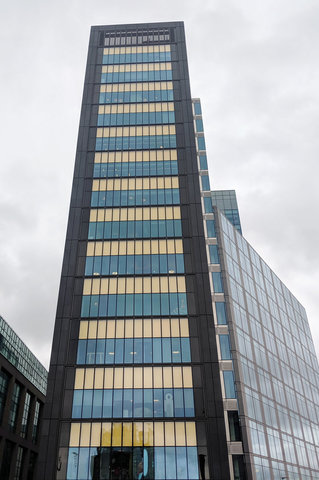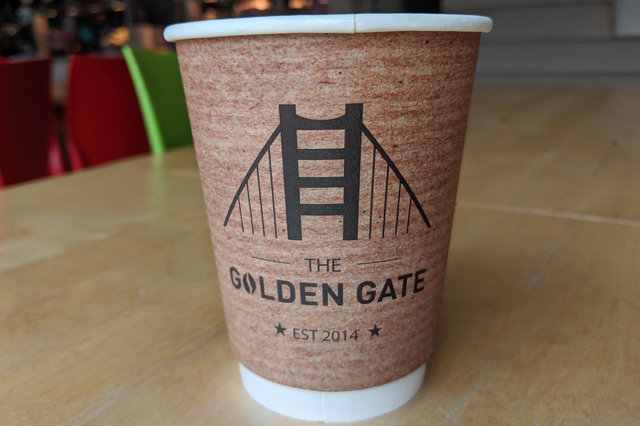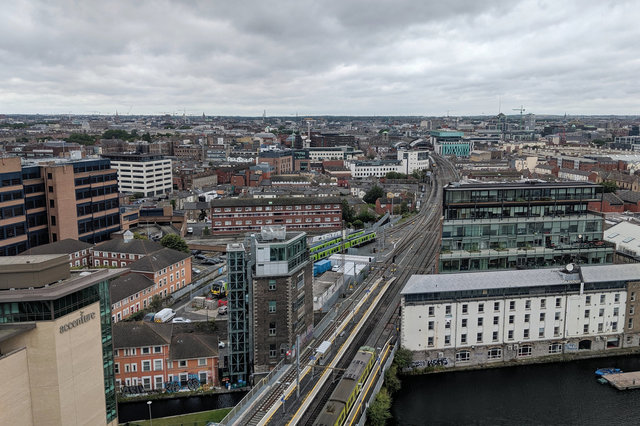Kilmainham
Started: 2019-09-11 22:20:23
Submitted: 2019-09-12 01:12:59
Visibility: World-readable
22nd August 2019: In which the intrepid narrator sees the Book of Kells (and the Crowd of Kells and the Queue of Kells) and takes a deep dive into Irish Republican history
On my last full day in Dublin, Kiesa took the kids to Phoenix Park, giving me the opportunity to see the city by myself.
My first stop was Trinity College Dublin, where I had a timed ticket to see the Book of Kells. I picked up an audio tour and dove into the exhibits explaining medieval illuminated manuscripts in detail, including a minute-long video showing how a book was bound using medieval technology. After learning about vellum and pigments and ink and the artistic expressions of the monks copying the manuscript I stepped into the next room to join the crowd around the glass display case trying to look at the pages of the Book of Kells that were set up for us to see. The book was bound into two volumes, and each volume was propped open, under glass, to a specific page (leading to the joke that we only got to see the "Page of Kells"; though since it was a printed book we could really see the "Spread of Kells"). The book was impressive, but a bit anti-climatic; I didn't really expect to be able to thumb through the priceless book on my own but I was at least hoping for more high-resolution pictures to look through.
The tour continued upstairs into the Long Room, a massive barrel-vaulted room holding the oldest and most impressive books in the deposit library's collection, now crowded with tourists marveling at the neat stacks of books on two levels.
Each shelf was decorated by a bust of someone important, though I confess I wasn't paying as much attention to the identity of the people depicted in the busts as I was to the room itself.
I traversed the length of the Long Room and descended the stairs into the crowded gift shop, then outside, where a light rain had begun to fall. I walked past the long queue of people waiting for admission without timed tickets and found a piece of sculpture, Sphere with sphere by Arnaldo Pomodoro, sitting in a plaza between the old library and the new library. I've seen his work in sculpture gardens before, and I appreciated the opportunity to see it again here on another continent.
I left Trinity College and walked around the corner to the DART commuter
rail station. I rode two stops to the Grand Canal Docks, the site of my
employer's office in Dublin (and, due to loopholes
features in European tax law, supreme European headquarters).
I badged into the office (mostly so I could take credit for visiting the office on the internal website that tracks such things) and got a cup of coffee -- which I was surprised to see was served in a cup depicting my favorite bridge, halfway around the planet from where I stood on the edge of Europe. (It seemed just as out-of-place as the Seattle's Best Coffee sign I saw in the train station on my way to the office.)
I took the elevator to the eleventh floor and looked out at the city of Dublin. In a week in the city this was the first time that I could see the green hills surrounding the city. We didn't get the chance to visit the legendary Irish countryside, so instead I focused my attention to the rail lines running through the city, and the urban cityscape stretching to the horizon in front of me.
I took the train into central Dublin to the General Post Office, which is both a working post office and also the site of the headquarters of the 1916 Easter Rising, in which Irish Republicans rebelled against British rule of Ireland, until the British Army shelled the building and the surrounding neighborhood into rubble, from gunboats in the River Liffey, forcing the unconditional surrender of the rebels still alive inside.
I paid for admission to the Witness History museum, which laid out the background behind the Easter Rising and examined the Rising itself in detail. Just as I was sitting down to watch a short dramatized movie about the Easter Rising the fire alarm went off -- but it was so well timed with the start of the movie that I first thought the flashing strobe light and sirens were in fact part of the multimedia experience. I evacuated the basement gallery and waited on the ground floor for the staff to confirm that it was, in fact, a false alarm; they reset the alarm and I reentered the museum to be immersed in modern Irish history.
The rest of the exhibits in the basement museum galleries discussed the British response to the uprising (namely, rolling out the big guns and shelling the entire neighborhood to rubble) and the aftermath: the rising was not especially popular as it was happening, but as soon as the British executed all of the rising's leaders public opinion turned against the British, leading eventually to Irish independence by 1922.
Not that independence was enough to bring peace to Ireland. A series of exhibits upstairs, on the main floor of the post office, discussed the Irish Civil War (fought between the extremists who rejected the partition of Ireland and the realists who thought it was the best deal they could get) and the Troubles -- which I'm apparently just barely too young to remember directly, though it kept up until 1998, well into the time I could have remembered it on the news.
This seemed like a good moment to remember that the political tensions that boiled over in the Easter Rising are still alive, dormant but capable of being reawoken, in Northern Ireland. For twenty years Northern Ireland has been at peace through the Good Friday Agreement, allowing both the Unionists and Republicans to get what they want; but Brexit threatens to throw a spanner into the very delicate machinery by imposing a border somewhere -- either in the Irish Sea (unacceptable to Unionists), on the border between the Republic of Ireland and Northern Ireland (unacceptable to Republicans in Northern Ireland), or between Ireland and the rest of Europe (unacceptable to the entire Republic of Ireland). With Boris Johnson the newly-elected Prime Minister of the United Kingdom poised to enforce a hard Brexit on 31st October a cloud of uncertainty hung over the entire island.
(On the bright side, as I write this, Parliament in Westminster passed a bill requiring the Prime Minister to request an extension from the EU in the event that he doesn't have an acceptable Brexit deal, so the likelihood of a hard Brexit dropped precipitously in the several weeks that elapsed between my visit to Ireland and the time when I actually managed to write about it.)
I left the General Post Office with a big dose of Irish history. I got a snack (at a coffee shop embedded inside a bookstore down the street from the post office), then caught the tram westward to the National Museum of Ireland - Decorative Arts & History.
I spent an enjoyable hour wandering around the decorative arts exhibits inside the museum, including coins (which reminded me to go look at the Euro change in my pocket to figure out which country minted the coins -- I found coins from Austria and France as well as Ireland) and household furnishings throughout the centuries. On my way out of the museum I dropped by the yacht Asgard, used to smuggle weapons for the Irish Republicans ahead of the Easter Rising in 1916.
My last tourist stop of the day was another deep dive into Irish history at Kilmainham Gaol. (For reasons I don't understand, "Gaol" is pronounced like "Jail" in American English.) The gaol's tours had sold out by the time I thought to look for them, but the website left me some hope by mentioning that cancellation tickets would be released each morning for that day's tours. I checked the tickets on my phone in the morning, while standing outside the walls of Trinity College Dublin, and found a spot in the 16:00 tour.
The tour started in the adjacent courtroom, a cramped room apparently used for trials convenient to the inmates at the gaol. The tour started in the chapel with a video giving the history of the gaol. Our tour guide took us into the oldest part of the gaol, where cells intended for one or two people would be crammed with people rendered destitute by the Irish Potato Famine.
The tour continued into a somewhat-newer cellblock where the leaders of the Easter Rising were held until they were tried, convicted, and executed.
Finally the tour took us into the new east wing, opened in 1862, built as a panopticon on the theory that prisoners could be reformed if only the prison architecture supported it.
The main cell block was stunning: ninety-six cells built of brick, all opening inwards, all designed to encourage the inmates to sit in silence because their jailers could observe them at any time.
It was simultaneously fascinating and terrifying to see the prison architecture: built with light streaming through the skylights into the central atrium but built for constant surveillance.
After the main cellblock the final stop on the tour was the Stonebreaker's Yard, where the leaders of the Easter Rising were executed, turning the tide in the Irish independence movement.
After the tour I looked through the museum, which covered some of the same ground as the General Post Office museum. I emerged from the gaol and caught a bus back to the apartment. No one wanted to leave the apartment for supper, so I found an Indian take-away restaurant a few blocks away and went there to pick up supper to bring back to the apartment. I wrapped up the evening by packing for our return to North America the next day, after a week in Dublin.
I have a few more pictures from my last day in Dublin at Photos on 2019-08-22.


















